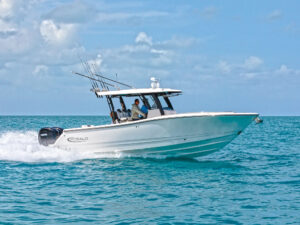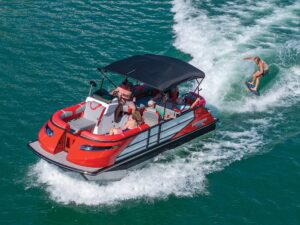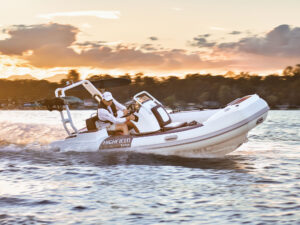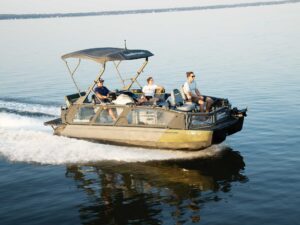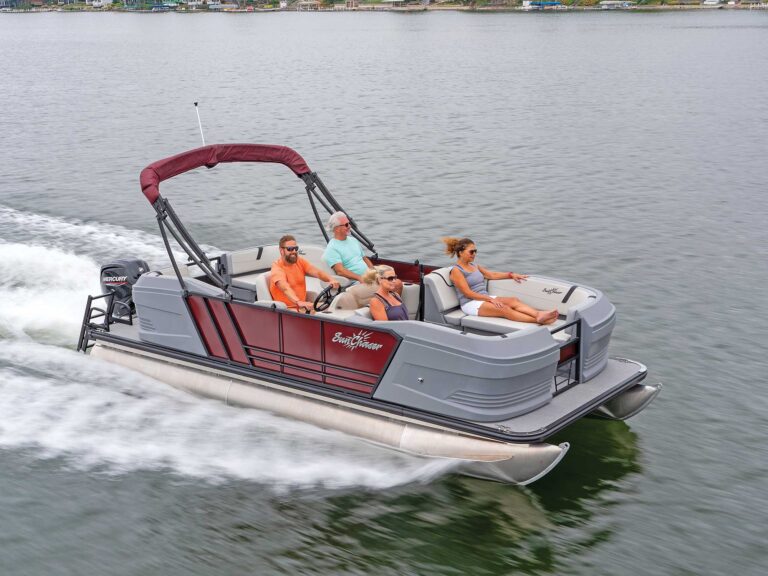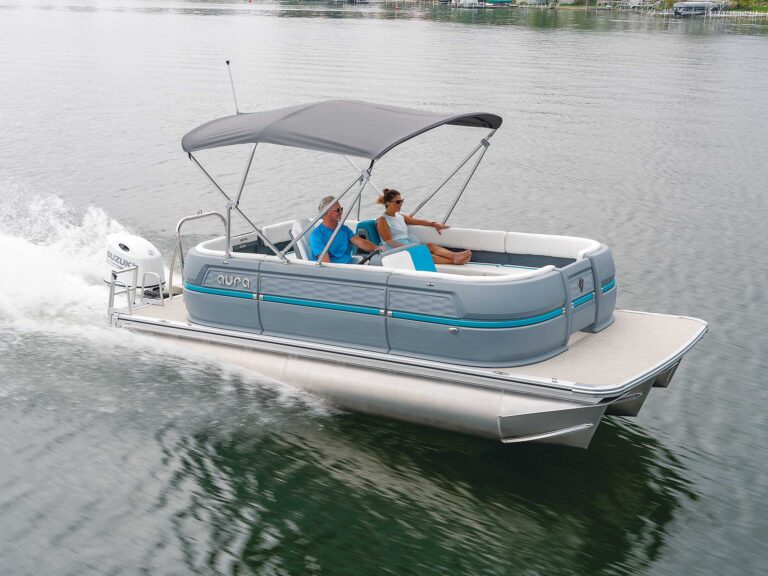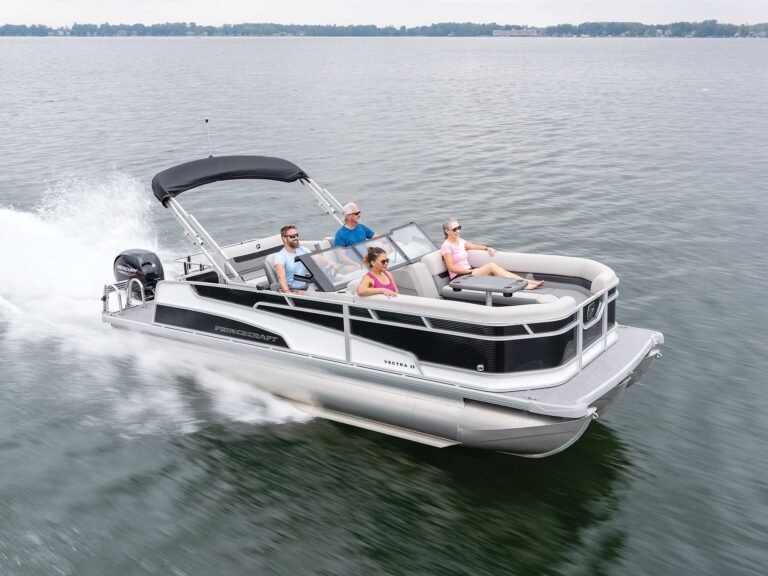As I walked down the docks to test the new Sea Ray 22 Pachanga, my first thought was, “Anyone who liked the original Pachanga will love this one.” From the aggressive lines to the classic graphics to the deep freeboard, the 22 Pachanga is reminiscent of the success Ford had when it the updated the Mustang and of what Chrysler pulled off with its sharp new Dodge Challenger.
When I was running down the list of equipment, I was surprised to find that Sea Ray had packaged the prototype’s optional 425-hp MerCruiser 496 MAG HO with a Bravo Three twin-prop drive. For a high-performance application, the Bravo One or XR would usually be the drive of choice. Sea Ray says the Bravo Three was chosen to improve the boat’s planing time and to keep the top speed at 65 mph. Also, by keeping the top speed under 70 mph, Sea Ray didn’t need to include hydraulic steering as part of its standard equipment, per Mercury Marine recommendations.
Comparatively, Donzi’s 22 Classic, which is available as a Limited Edition 2009 model ($85,714) runs 75 mph powered by a 496 MAG HO Bravo One X and Checkmate’s ZT 240 hits similar speeds with a 375-hp 496 MAG HO Bravo One. The Sea Ray has superior cockpit space and freeboard over the Donzi, and both the Donzi and Sea Ray exhibit a fit and finish superior to the Checkmate.
True Colors
As I said, the test boat was a prototype, so it was probably heavier than production models will be. It hit a top speed of 62.8 mph at 5000 rpm. The 21-degree V-bottom with four strakes tracked smartly, and I think this hull could easily handle more power. The Bravo Three and Lenco trim tabs worked well in tandem to get the boat on plane in 4.9 seconds. Without the tabs, the 22 Pachanga planed in 6.1 seconds. During midrange acceleration tests, I ran from 30 to 40 mph in 4.8 seconds and from 40 to 50 mph in 4.7, both respectable numbers. Some tweaking is still needed to get the boat to work better for skiing or boarding. I used the tabs to help the 22 Pachanga run about 20 mph at 2500, but it was clearly unhappy running this speed. Sea Ray says this issue will be resolved on future models.
During maneuvers the 22 Pachanga handled like a open-wheeled racecar, whipping through slaloms at 40 mph and carving clean sweeping arcs at 50 mph. Low-speed maneuvering isn’t an issue with 425 hp and twin props.
Looking at power options for the boat, the best all-around performer in my opinion might be the 320-hp MX 6.2 MPI Bravo One. At 993 pounds, it has a power-to-weight ratio of 3.1 pounds per horsepower, while the 1,224-pound 496 MAG HO Bravo Three has a ratio of 2.88, and that doesn’t include the weight of the Mercury Racing Integrated Transom System. Also, with the smaller block and a single prop, you wouldn’t suffer the power loss that results from spinning two props. A friend of mine owns a pair of classic 22 Pachangas: a 1987 equipped with a 330-hp 454 MAG, and a 1986 installed with a 270-hp 350 MAG. His small-block boat runs 62.9 mph, whereas the big-block-powered model tops out at 60.9 mph. Finally, the MX 6.2 would get better fuel economy, too.
Classical Curriculum
Even though the small-block would also be advantageous when it comes to space in the engine compartment, the area is still plenty roomy for the larger 496 MAG HO. Getting to the engine is a three-step process. Remove the bench seat bottom cushion with handy loop-style straps. Then release a latch for the engine hatch and lift it manually on twin gas struts. The hatch consists of most of the aft lounge to provide good access. The engine is installed with through-bolted mounts, and there are inspection hatches outboard on each side to let you get to the backing nuts.
The anchor stows in a box on the port side of the compartment. Twin batteries are separated on each side for proper weight distribution. You can’t beat the Lenco tabs for easy rigging because all you need to do is run wiring to the dash, not hydraulic lines. The drive trim pump is on the transom, in a spot where it’s easy to top off with fluid.
The look of the engine compartment is super clean thanks to a fully molded liner. The cockpit also uses a liner for a seamless look and feel.
I sat in the bench seat up to my shoulders. Stowage was in the base in a molded draining locker. I found more stowage in side gunwale trays that were plenty large enough for fenders and dock lines.
Up front, the supportive twin buckets swivel and slide fore and aft. Kudos to Sea Ray for designing a windshield you can actually see through while you’re seated, instead of trying to see around it by hunkering down or craning your neck. There’s a good-sized glovebox in the port dash. To starboard, the instrument panel looks cool enough to be sitting inside a Corvette, but the layout needs one important change: The drive trim gauge should be moved to the center of the panel. Zero Effort controls are comfortably positioned and the trim switches are set up runabout-style (push the buttons forward and the bow goes down) for an easy transition for runabout drivers.
Forward in the bow, the cabin has a large adult-sized cushion, plus some movable pads that are about 1′-long with integrated cupholders. A deck hatch lets in air for a couple overnighting and of course, there’s an MP3 plug for your collection of classic-rock hits. Hey, let’s get the party started.
MSRP: Standard power – $62,300 Test power – $78,300 ****
Sea Ray Boats – Knoxville, Tennessee; searay.com

